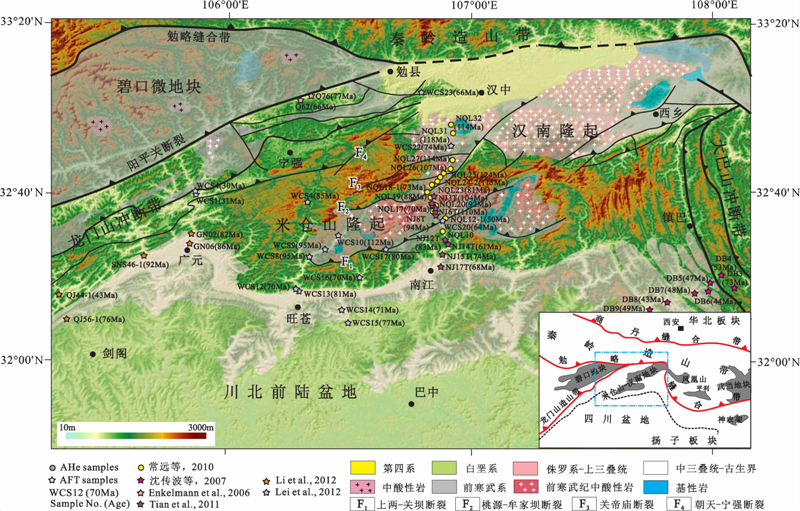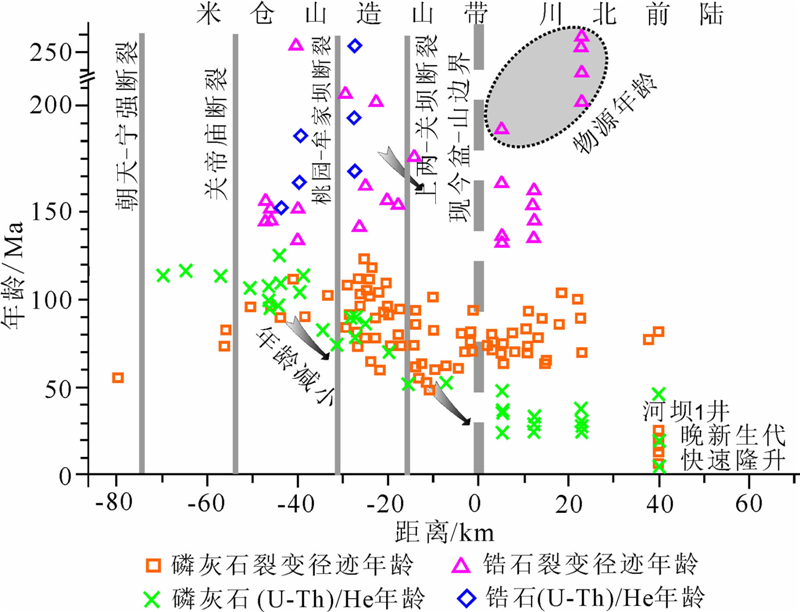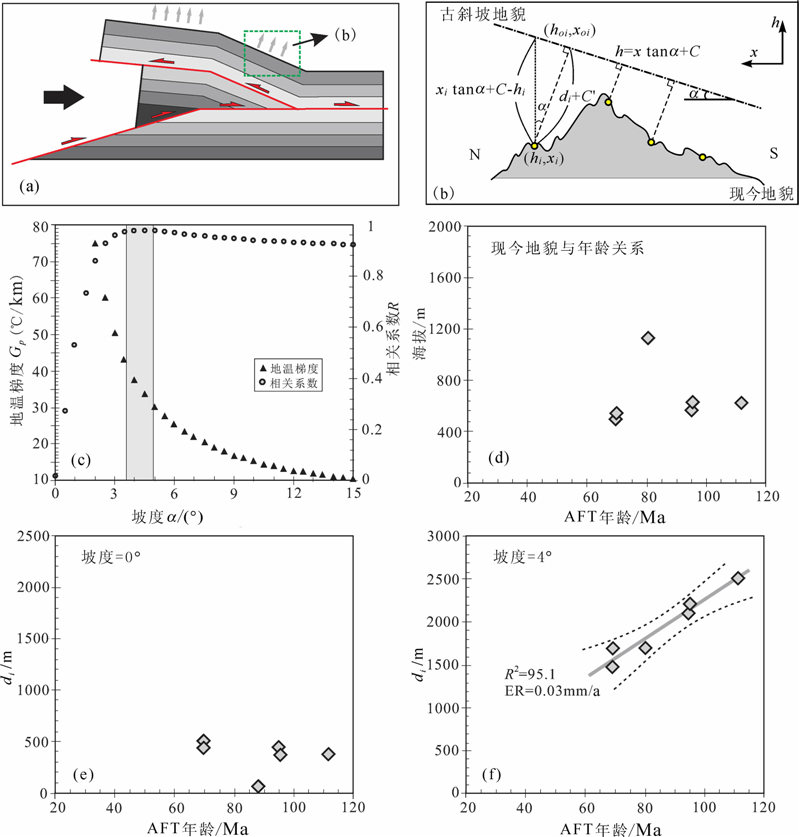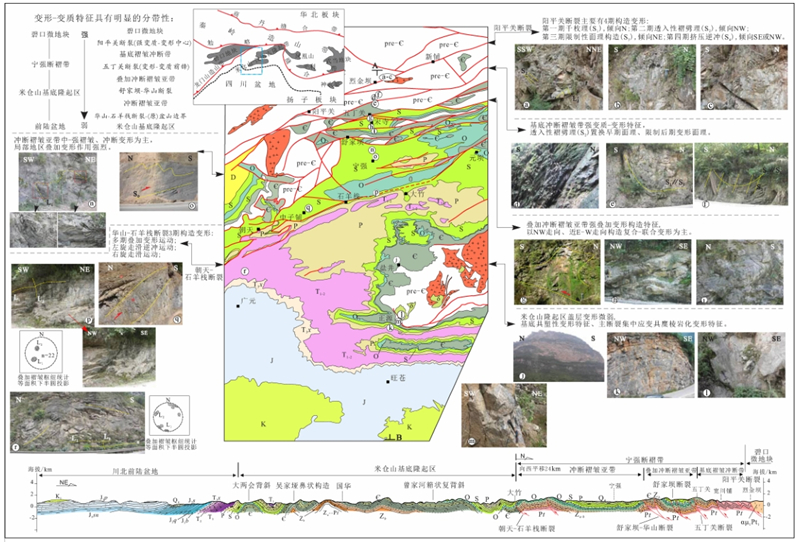2. 成都理工大学“国土资源部构造成矿成藏重点实验室”, 成都 610059;
3. Japan Atomic Energy Agency, Toki, Japan, 5095102
2. Key Laboratory of Tectonic Controlled Mineralization and Oil Reservoir, Ministry of Land and Resources, Chengdu University of Technology, Chengdu 610059, China;
3. Japan Atomic Energy Agency, Toki 5095102, Japan
1 引言
造山带与盆地具有复杂互馈的成山成盆演化历史,该过程受控于不同的外部(如:剥蚀与气候、沉积负载等)和/或内部因素(如:岩石圈深部机制等)及其耦合过程,对盆-山系统结构建造及其“从源到汇”的量化过程等成为有效解译成山成盆(及盆内成藏)动力学的关键契机(Willett,1999; Beaumont et al., 2001; Thiede et al., 2004; Whipple,2009).因此,与低温热年代学有机结合的构造重建(或解译)与浅部地表过程量化模型受到越来越广泛的重视与应用(Braun,2005; Whipp Jr et al., 2007; Malusà et al., 2011; Reverman et al., 2012).造山带-盆地系统广泛的研究揭示不同成因机制对成山成盆演化过程的有效作用:(1)内部结构机制,如:主边界断裂、楔形体系等有效结构(Martin et al., 2005; Fuller et al., 2006; Godard and Burbank, 2011);(2)外部(模型)边界条件,如:剥蚀强度与气候特征、碰撞动力学特征等(Whipp Jr et al., 2007; Ehlers et al., 2006; Bettinelli et al., 2008);(3)差异性演化过程等(McQuarrie et al., 2008; Metcalf et al., 2009).由于盆-山系统内在的复杂规律,如何系统、有效地把不同内部和外部机制及其耦合过程纳入对成山成盆演化的解译仍存在较大分歧.
盆-山系统中不同结构带岩石普遍具不同的时间-温度热演化史,它们被多封闭体系热年代学所记录(如:40Ar/39Ar MDD,FT,(U-Th)/He等),因而样品的热年代学年龄及其特征表现出不同的系统变化规律(Metcalf et al., 2009; Ehlers and Farley, 2003),如:低温热年代学所记录的最大和最小温度伴随构造位置的不同而产生系统变化.如果在一定的或者相似的构造格架(即盆-山体系)中,不同位置的岩石会经历相似的时间-温度热演化史(Whipp Jr et al., 2007; Fuller et al., 2006; Sueoka et al., 2012),所有样品的热演化史应具有明显的相关性和系统性,即构造模型与浅部地表过程耦合性(表现为低温热年代学特征).
米仓山造山带位于青藏高原东缘,为扬子板块北部四川盆地盆缘突出的前寒武纪基底隆起带(图 1),其形成演化是中国南北大陆碰撞造山过程的谜团,且涉及青藏高原东缘龙门山-大巴山造山带与四川盆地复合盆-山体系的核心问题而备受国内外关注(Wang et al., 2003; Enkelmann et al,2006; Li et al., 2007; Xu et al., 2009;Ratschbacher et al., 2003; 张国伟等,2004).由于地表露头、地震数据观测的差异性,对米仓山—川北前陆盆山系统区域滑脱层系(如:中下三叠统、寒武系、震旦系和元古界变质岩)、构造变形样式及其动力学模型(如:基底卷入冲断、双重构造冲断、楔入构造冲断等)存在较大争议(Xu et al., 2009; 李岩峰等,2008;吴磊等,2011;文竹等,2013).因此,我们通过低温热年代学数据展开米仓山—川北前陆盆山系统楔入冲断构造模型与浅部地貌建造(非)耦合的检验校正,进一步结合野外地质特征探讨扬子板块北缘米仓山盆-山结构建造及其动力学过程,为扬子板块北缘盆-山系统的研究提供基础证据.
 | 图 1 米仓山区域地质特征及低温热年代学样品分布图 Fig. 1 Topography from SRTM digital elevation model and geological setting of the Micangshan,it shows most of low-temperature thermochronometer data in the Micangshan and its periphery |
米仓山西起四川广元、与龙门山相接,东至陕西西乡、与大巴山相交,长约150 km,宽约50 km,呈近东西向展布,是扬子板块北缘(四川盆地)与摩天岭微地块、秦岭造山带相接的边界(图 1).米仓山—川北前陆盆-山结构带地貌反差较大,造山带平均海拔高度为1000~2000 m,其最高峰约为2500 m;而山前川北前陆盆地平均高程为400~800 m(图 1),仅通南巴背斜高程较高,为900 m左右.米仓山与前陆盆地海拔落差大于1000 m,且山前陡变带宽约15 km,因此造山带-前陆盆地界线坡度较陡,盆-山边界具明晰的线型特征.
米仓山隆起带受四川盆地北缘(扬子板块北缘)向北深俯冲动力作用控制,岩石圈厚度由南向北从盆内80~100 km急剧增厚至造山带~125 km,导致岩石圈深部物质伴随大规模向东、向西侧走滑构造变形而挤出或沿垂向构造抬升变形挤出(程顺有等,2003),大规模物质逆冲叠置隆起形成汉南—米仓山隆起带,构建米仓山—川北前陆盆地盆-山结构(魏显贵等,1997;吴德超等,1998; 刘树根等,2011),其构造变形特征具有显著的南北分带性和东西分段性(吴世祥等,2006).值得指出的是,具褶皱冲断和滑脱推覆变形特征的基底与变形微弱的沉积盖层之间显著的构造差异性揭示出米仓山构造变形纵向上具有明显的滑脱性和分层性,因而导致对区域滑脱层系的不确定性和造山带基底卷入冲断或是楔入构造冲断变形模型的巨大分歧(Xu et al., 2009;李岩峰等,2008;吴磊等,2011;文竹等,2013).
晚三叠世扬子板块北缘向北深俯冲,导致发生大规模逆冲推覆,奠定了汉南—米仓山隆起的主体构造格架(魏显贵等,1997),其前缘沉积巨厚上三叠统须家河组磨拉石和侏罗纪红层,它们在米仓山南北部具有较好的对比性,但白垩系仅分布于米仓山隆起南侧,揭示汉南隆起和米仓山隆起分别形成于印支晚期和燕山期,具前展式变形过程.因此,米仓山—川北前陆盆山体系是在印支期碰撞造山作用基础上,叠加燕山中晚期(J3-K1)陆内造山作用(施炜等,2007;裴先治等,2009)形成的板缘突变型盆山结构(Liu et al., 2012),其快速抬升剥露过程得到大量地质年代学和热年代学年龄印证(许长海等,2010;Tian et al., 2011;Li et al., 2012; Lei et al., 2012).2.2 米仓山区域低温热年代学特征
米仓山及四川盆地北部地区(主要为前寒武纪火成岩、变质岩及少量碎屑岩样品)已开展过大量热年代学工作(Enkelmann et al., 2006;许长海等,2010; Tian et al., 2011; Lei et al., 2012; Li et al., 2012; 邱楠生等,2008; 常远等,2010),获得深部-浅表地层晚古生代以来主要热-构造事件和隆升-剥露过程,尤其是米仓山—汉南隆起带(图 1).
由于样品空间分布差异性,关帝庙断裂以北锆石裂变径迹样品缺少,同时区域锆石(U-Th)/He(ZHe)样品也较少,其主要分布在桃园—牟家坝断裂两侧(图 1、图 2).总体而言,区域锆石裂变径迹年龄值主要集中在170~140 Ma,反映区域燕山早期整体性抬升冷却事件.盆内川北前陆和川东北前陆该时期发生强烈负载沉降,低温热年代学热史模拟也揭示地层发生最大埋深(许长海等,2010; 刘树根等,2006),与前陆盆地主建造期相印证.桃园—牟家坝断裂附近部分样品锆石裂变径迹年龄为晚三叠世,揭示早期构造抬升活动.前陆盆地碎屑岩样品单颗粒锆石(U-Th)/He年龄明显大于其地层沉积年龄(邱楠生等,2008),反映盆内样品埋深未超过锆石(U-Th)/He封闭温度(170~190 ℃,据Reiners et al., 2004),未发生完全退火.
 | 图 2 米仓山倾向结构带低温热年代学特征对比图 图中低温热年代学数据据邱楠生等,2008; 常远等,2010; 许长海等,2010; Tian et al,2011; Lei et al., 2012. Fig. 2 The south-ward decreasing feature of the low-temperature thermochronometer in the Micangshan Low-temperature thermochronometer data is from Qiu et al., 2008; Cang et al., 2010; Xu et al., 2010; Tian et al,2011; Lei et al., 2012. |
米仓山—川北前陆盆山结构倾向上(从N向S),总体具有年龄变小趋势(图 2),尤其是磷灰石(U-Th)/He年龄(AHe).桃园—牟家坝断裂以北磷灰石(U-Th)/He年龄大致为110 Ma,其南部逐 渐减小,到盆内地表样品年龄大致为30 Ma,桃园— 牟家坝断裂附近具有明显的年龄跃迁特征,揭示汉南—米仓山基底—前陆地区差异性构造抬升与剥露活动.
磷灰石裂变径迹样品(AFT)在米仓山—川北前陆地区分布最广、最为系统,其年龄总体具有由北向南减小趋势.关帝庙断裂与上两—关坝断裂间AFT年龄集中在大约100 Ma,上两—关坝断裂至川北前陆盆地AFT年龄集中在90~70 Ma,反映出区域晚白垩世快速隆升剥露事件.同时米仓山关帝庙断裂以北,磷灰石裂变径迹年龄可能具有减少的变化趋势,其北部3个样品AFT年龄小于80 Ma,但也可能是由于样品稀少因素导致.至盆内钻井河 坝1井磷灰石裂变径迹和(U-Th)/He年龄都集中在晚新生代(<20 Ma),它与磷灰石裂变径迹热史模拟共同揭示出晚新生代以来快速隆升剥露事件,可 能与青藏高原东向扩展密切相关(Tian et al., 2011; Lei et al., 2012).
3 米仓山造山带楔入冲断构造特征 3.1 楔入冲断构造低温热年代学模型检验构造模型与浅部地表过程相关的低温热年代学(非)耦合性,如:磷灰石裂变径迹(AFT)、(U-Th)/He等,我们需了解浅部地温场和不同低温热年代学封闭温度等温面特征等.一般而言,浅部地层温度与地表温度和地温梯度具明显关系:

我们假设盆-山建造过程中伴随造山带楔入构造冲断变形过程浅部岩石受后缘挤压构造变形控制,发生稳态抬升剥露作用,后缘构造加积作用与浅部岩石抬升剥露作用相一致,即浅部岩石具恒定垂向抬升剥露速率(图 3),因此,浅部地表具稳态地温 场特征(Stüwe et al., 1994; Brandon et al., 1998):

 | 图 3 米仓山稳态楔入冲断构造模型及其西段热年代学特征 (a)造山带楔入冲断构造模型(from Shaw et al., 2005),稳态抬升剥露过程假设楔入构造后缘挤压加积作用与浅部岩石抬升剥露作用相一致;(b)楔入冲断构造相关米仓山盆地向倾斜古地貌模型及其模型相关参数,h为楔入冲断变形期古地貌高程,C和C′恒定参数,di为样品古地貌垂直高程,di=(xitanα-hi)cosα;(c)米仓山西段古地貌斜率(α)、古地温梯度(Gp)和二者的有效指数(R2)对比关系图,当古地貌斜率α=~4°(灰色标注带)有效指数达到最大值(R2=~98%);(d)现今样品高程-低温热年代学年龄关系图(AERs),揭示米仓山西段地区磷灰石裂变径迹年龄与样品海拔高程的非相关性;(e)—(f)分别为古地貌斜率α=0°和α=4°时,米仓山地区磷灰石裂变径迹年龄 样品古高程(di)对比关系图,揭示米仓山西段古地貌斜率α=4°时AFT年龄与楔入构造模型典型的线性关系特征. Fig. 3 Wedge-thrust folding model on low-temperature thermochronological ages in western segment of the Micangshan (a)Wedge-thrust folding structure(from Shaw et al., 2005)indicated by the seismic profile and field observation in the Micangshan;(b)Schematic map of titled topography and parameters in the model,the h indicates the height of paleo-topography after wedge-thrust folding deformation,C and C′ are constants,di is the relative distance from each sampling site to the paleo-topography and is given by(xitanα-hi)cosα;(c)The slope angle α vs paleo-geothermal gradient Gp and coefficient of determination R2 in western segment of the Micanshan,R2 attains the maximal value when slope angle is about ~4°(shown as the shaded zone);(d)In-situ AERs showing no correlation between elevation and AFT ages in western segment of the Micanshan;(e)—(f)The AFT age vs the di in different slope angle(α=0°, and α=4°)showing the correlation between the topographic slope and AFT ages in western segment of the Micanshan. It suggests a steady-state uplift and exhumation took place in the Micangshan during Late Cretaceous time with a basin-ward ~4° titled topography. |
不同矿物低温热年代学封闭温度是其抬升冷却速率的函数(dT/dt),Dodson(1979)基于阶段性加热分子扩散实验得出其经验关系式:

Dodson(1979)主张式(3)经验符合50%裂变径迹退火模型(即E50%),Reiners and Brandon(2006)进一步强调该经验公式更加符合具有稳态单一抬升剥蚀过程的裂变径迹和He年龄体系退火模型.米仓山地区区域地质资料表明其晚中生代盆-山建造期后处于持续隆升过程,未发生过埋深退火或新生代岩浆热事件.
岩石样品抬升通过浅部地表不同矿物封闭温度等温面时的冷却速率是稳态剥露速率和浅表地温场的函数:



基于上述公式,古地表温度和古地温梯度已知条件下,能够建立多矿物低温热年代学体系的年龄(τ)-稳态剥露速率(ε)-封闭温度(Tc)函数关系(Brandon et al., 1998; Reiners and Brandon(2006)).然而,浅部地表地貌起伏度、剥蚀速率等会导致不同等温面发生相应弯曲变化及其系列复杂效应(Stüwe et al., 1994; Mancktelow and Grasemann, 1997;Braun,2002;邓宾等,2013).米仓山地区普遍具有较大的低温热年代学年龄(图 2),根据四川盆地相似的平均年龄计算揭示其隆升剥蚀速率普遍小于~0.4 mm/a(Deng et al., 2013a,2013b),同时楔入构造冲断变形导致其具有较大的地貌波长,我们认为浅部地表等温面将会遵循楔入构造冲断模型导致的大波长地貌起伏特征(图 3).因此,其样品稳态剥露过程为

由于(盆-山建造期)古地表温度和古地温梯度的不确定性,为验证造山带区域样品的相关性和系统性抬升问题,我们引入相关性常数,即有效性指数(R2)来对比(倾斜)古地貌上样品剥露过程与其封闭温度的关系:

基于公式(3),(4),(5),(7)和(8),我们能够得到楔入冲断构造相关的古倾斜地貌斜率、古地温梯度和有效指数的协和图,以及不同低温热年代学年龄和样品古高程之间的线性关系来验证古倾斜地貌与低温热年代学特征的(非)耦合效应. 3.2 米仓山楔入冲断构造模型
米仓山地区低温热年代学年龄样品主要分布在米仓山西段旺苍—宁强地区及其中间部分南江—汉中地区(图 1).旺苍—宁强地区磷灰石裂变径迹(AFT)样品主要来自于晚三叠世-早白垩世碎屑岩及前寒武纪花岗岩,采用外探测法测试获得AFT 年龄.AFT年龄主要为70~95 Ma,径迹长度为10.6~ 12.3 μm(Lei et al., 2012; Li et al., 2012),揭示样品发生完全退火、样品年龄为其冷却年龄,且样品在浅部地表发生缓慢抬升冷却退火过程.南江—汉中地区,磷灰石裂变径迹(AFT)和(U-Th)/He(AHe)样品主要来自于前寒武纪花岗岩、闪长岩和少量古生代-中生代碎屑岩,其AHe年龄为50~ 120 Ma,为样品冷却年龄,AFT年龄为60~120 Ma、 径迹长度为12.3~13.2 μm(常远等,2010; Tian et al., 2011).因此,我们分别对米仓山西段和东段展开楔入冲断构造AFT年龄热模型和楔入冲断构造AFT-AHe年龄热模型的检验校正(图 3,图 4).
 | 图 4 米仓山东段稳态楔入冲断构造模型热年代学特征 (a)米仓山东段古地貌斜率-古地温梯度-有效指数关系图;(b)米仓山东段现今样品高程-低温热年代学年龄关系图(AERs);(c)—(d)米仓山东段古地貌斜率分别为α=0°和α=4°时,AFT和AHe年龄与样品古高程(di)对比关系图. Fig. 4 Wedge-thrust folding model on low-temperature thermochronological ages in eastern segment of the Micangshan (a)The slope angle α vs paleo-geothermal gradient Gp and coefficient of determination R2 in eastern segment of the Micanshan,R2 attains the maximal value when slope angle is about ~4°(shown as the shaded zone);(b)In-situ AERs showing no correlation between elevation and AHe-AFT ages;(c)—(d)The AHe-AFT age vs the di in different slope angle(α=0°, and α=4°)showing the correlation between the topographic slope and low-temperature thermochronologcal ages. |
米仓山楔入冲断构造低温热年代学模型揭示,米仓山造山带浅部地表低温热年代学特征与楔入构造模型具有明显的相关性,形成与冲断构造变形相关的盆地向倾斜古地貌,古地貌坡度、低温热年代学特征和古地温场具有良好的相关性.米仓山西段古地貌坡度为3.5°~5°时,古地温梯度与古地貌坡度具有最大相关性(R2=~98%),古地温梯度为30~35℃(图 3c),该区间值与区域地质特征具有较大吻合性(Hu et al., 2000; 胡圣标等,2001).符合模型检验低温热年代学样品为寒武纪碎屑岩和前寒武纪火成岩样品(如:WCS8、WCS9、WCS10、WCS12、WCS16等),主要位于米仓山—川北前陆盆山系统 盆-山过渡带(图 2),其海拔高程主要为500~600 m. 现今地表AFT年龄与海拔高程不具线性关系,且古地貌坡度为0~3°时也不具有明显的线性相关性(图 3d,图 3e).但当古地貌坡度为~4°时,AFT年龄与样品古高程具有明显线性相关 性(图 3f).通过Isoplot 插值法计算(Ludwig,2000),揭示晚白垩世(110~70 Ma)其稳态抬升剥蚀速率为0.03 mm/a.
米仓山东段古地貌坡度为3°~5°时,古地温梯度与古地貌坡度具有最大相关性(R2=~95%).低 温热年代学反映出古地温梯度总体为20~35 ℃/km(图 4a),该区间值与区域地质特征具有较大吻合性(Hu et al., 2000; 胡圣标等,2001).但AFT低温年代学体系揭示古地温梯度为20~35 ℃/km,而AHe低温年代学体系揭示古地温梯度为20~25 ℃/km,AHe体系反映出较低的古地温梯度特征,可能与其更易受浅部地貌冷却作用等因素有关.符合模型检验的AHe样品为前寒武纪火成岩和变质岩样品(如:NQL10、NQL17、NQL19、NQL24-2、NQL27、NQL31等),AFT样品为古生代-新生代碎屑岩样品(如:NJ12T、NJ15T、NJ17T、NQL19、NQL23、NQL25等),样品南北空间跨度较广,从盆-山过渡带至米仓山隆起带北部(图 2),现今海拔高程跨度较大、为400~1500 m.现今地表AFT和AHE年龄与海拔高程都不具线性关系,且古地貌坡度为0~3°时也不具有明显的线性相关性(图 4b,图 4c).当古地貌坡度为~4°时,AFT和AHe年龄与样品古高程体现出明显线性相关特征(图 4d),共同揭示米仓山晚白垩世(110~60 Ma)具相似的稳态抬升剥蚀速率~0.05 mm/a.米仓山东西两段具有总体一致的晚白垩世稳态抬升剥露速率.晚白垩世较低的抬升剥露速率与米仓山地区AFT和AHe热模型模拟的时间-温度曲线具有明显相似性(常远等,2010; 许长海等,2010; Tian et al,2011),揭示区域长地质时间尺度上具低速率稳态抬升剥露特征.
4 米仓山楔入冲断盆-山结构地质学特征米仓山野外地质特征研究表明,盆-山结构带沿造山带向前陆盆地方向(从N向S)构造变形逐渐减弱、具南北分带性,可分为米仓山叠加复合带(宁强断褶带)、米仓山基底隆起带和川北前陆盆地三个单元(图 5).米仓山叠加复合带位于阳平关断裂与华山-石羊栈断裂之间,主要受龙门山造山带、碧口微地块和米仓山基底隆起带等复合-联合作用控制,体现出强变质、强叠加变形特征.根据五丁关断裂、舒家坝断裂该带可进一步划分为基底冲断褶皱带、叠加冲断褶皱亚带和冲断褶皱亚带.基底冲断褶皱带主要出露前寒武变质基底,地层普遍发生强变质-变形作用,透入性(褶)劈理普遍置换原始沉积面理(图 5(d—f)).区内断裂普遍具多期构造变形特征,多期面理发育,如:阳平关前缘断裂带具第一期倾向N的千枚理、第二期NW倾向透入性褶劈理、第三期NE倾向限制性构造面理和第四期NW向SE逆冲的牵引劈理等(图 5(a—c)).叠加冲断褶皱亚带以下古生界出露为主,具有多期叠加变形构造特征,区内体现出主要为NW走向和近E-W走向构造线理及其复合-联合变形特征(孙东等,2011).由于斜交或正交等叠加过程,体现出复杂的叠加样式和图纹,如:马鞍状、球状或穹顶状等(图 5(h—i)).同时由于由北向南的强逆冲变形构造作用,区内志留系发育大型逆冲相关滑脱变形(图 5g,图 5o).冲断褶皱亚带具有中-强褶皱、冲断变形作用,在西段与龙门山造山带结合部具明显叠加变形作用(图 5r),区内断裂带多期构造变形活动特征明显.

|
图 5 米仓山南北综合构造分带特征及实测构造剖面图 Fig. 5 N-S structural features of the Micangshan, showing distinct segmengtation and decrease in deformation from the north ti south |
米仓山隆起带为核部出露前寒武纪基底的复式背斜区,隆起带具褶皱冲断和滑脱推覆多期变形特征,总体上变形不强.前寒武结晶基底多期浅层次脆性和中-深层韧性叠加变形作用强烈,尤其是主断裂带集中应变具糜棱岩化变形特征,如:正源—朱家坝断裂等(图 5m);相反,沉积盖层以纵弯褶皱变形为主、形成箱状背斜褶皱样式(图 5j),地层普遍变形微弱,近水平或低角度展布为主.基底与沉积盖层显著区别表明米仓山构造变形纵向上具有滑脱性和分层性,孙东(2011)基于平衡剖面解释揭示米仓山地区下部构造层缩短率约20%、明显大于上部构造层(缩短率约10%).同时川北前陆盆地变形以单斜构造为主,盆内地层倾角普遍低缓或近水平展布,后期脆性破裂变形、擦痕阶步等构造发育.值得指出的是,野外露头发现米仓山盆山结构带前缘发育大量向北(造山带方向)的逆冲构造,且地震资料也揭示深部具相似逆冲结构(Xu et al., 2009; 李岩峰等,2008).
米仓山地区存在多套滑脱层,如:中下三叠统、寒武系、震旦系和元古界变质岩,由于滑脱层对区域构造变形的滑脱与分隔效应,导致地层展现出不同的变形组合样式和变形特征.吴世祥等(2006)和李岩峰等(2008)强调浅部滑脱层在米仓山建造过程中的作用,认为米仓山主要体现为盖层滑脱型变形;Xu et al.(2009)和吴磊等(2011)强调深部滑脱层逆冲推覆形成米仓山基底卷入型构造变形,冲断叠置形成米仓山基底隆起带;文竹等(2013)则强调米仓山地区不同滑脱层系(尤其是深部滑脱层系)相关的多个楔入构造叠置隆起,形成米仓山基底隆起带.不同构造模式分别强调不同滑脱层系在盆山结构建造期的重要作用,未重视扬子板块北缘从板缘边界勉略缝合带(或阳平关断裂带)—米仓山—汉南隆起带—川北前陆盆地明显盆地向扩展变形作用过程和盆地向变质-变形作用逐渐减弱的趋势.同时,深部地层强变质-变形特征也揭示深部滑脱层系集中应变作用,明显强于浅部滑脱层系.
楔入冲断构造模型强调深部和浅部滑脱层系对盆-山结构建造的主要控制作用(Shaw et al., 2005),以深部滑脱层系为主的盆地向冲断扩展和浅部滑脱层系反向冲断共同作用控制着楔入冲断构造模型,而浅部反向冲断构造作用对造山带前缘及前陆盆地具有强烈控制作用.同时,由于多套滑脱层系的存在而导致米仓山造山带分别以中浅层滑脱层系 为顶板和底板逆冲断层形成双重构造.滑脱层系对楔入冲断构造模型盆地向冲断扩展变形的吸收、减弱作用,导致浅部滑脱层系上覆层系造山带前缘、前陆盆地变形较弱,而明显区别于浅部滑脱层系下伏地层强烈冲断扩展变形特征.深部和浅部滑脱层系共同调节不同层系构造缩短变形作用,尤其是中浅层滑脱层系形成的双重构造,导致造山带强缩短变形(缩短量和缩短距离分别为~30 km和30%)到前陆盆地急剧减小(缩短量为~19%).因此,受控于深部滑脱层系,米仓山—川北前陆盆山结构带前缘隐伏叠瓦状冲断与区域浅部滑脱层(反向逆冲)结合形成楔入构造冲断结构、构建米仓山—川北前陆盆地突变型盆-山结构,其逆冲推覆作用相对较弱,为扬子板块北缘准原地型冲断带(山)-前陆盆地(盆)结构,该盆-山体系可能以隆升作用为主,其逆冲推覆作用相对较弱(李岩峰等,2008).米仓山造山带楔入冲断构造模型的发育可能受控于多套滑脱层系(尤其是深部和浅部滑脱层系)和扬子板块能干性基底对造山带盆地向扩展变形过程的阻挡作用.
5 讨论 5.1 米仓山楔入冲断构造过程非稳态效应剥蚀过程将会导致浅部地表热扰动,楔入冲断构造模型假设其后缘构造加积与浅部地层抬升剥蚀作用一致,具剥蚀与热稳态过程.然而,浅部地表常常由于热扩散、地貌冷却、加速抬升剥露等非稳态作用过程(Ehlers and Farley, 2003; Stüwe et al., 1994; Mancktelow and Grasemann, 1997;Braun,2002;Deng et al., 2013a,2013b),导致浅部地温场发生扰动变化(非稳态过程),从而影响低温热年代学年龄及其构造模型耦合检验.因此,我们利用Brandon等(1998)编汇的Crank-Nicholson有限差分方法来判定浅表地温场特征受非稳态过程(如:剥蚀速率)的影响.
我们分别检验不同系统低温热年代学封闭温度等温面由于非稳态剥蚀过程发生的动态变化特征,即抬升剥蚀速率从~0.0 mm/a分别快速增大到0.1 mm/a和1.0 mm/a时,封闭温度等温面的扰动变化特征(图 6).模拟过程中地温场特征,如:热产生率1.0 μW/m3,地表热流55 mW/m2等分别与现今地温场特征一致,其地温梯度值根据现今四川盆 地地温梯度和前述楔入冲断构造模型得到20~35 ℃/km 值,选取较大值进行检验校正(由于较高地温梯度更易受非稳态过程影响).模型模拟揭示,米仓山地区抬升剥蚀速率显著增加时(或相关的非稳态事件发生后),其不同系统低温热年代学(AFT和AHe)封闭温度等温面将会在3~4 Ma内恢复到初始状态的~20%内(即稳态恢复),而锆石(U-Th)/He封闭温度等温面相对延迟时间较长、也会在5~7 Ma内达到稳态恢复(图 6).伴随抬升剥蚀速率增大,会导致不同系统低温热年代学有效封闭温度增加、封闭温度等温面扰动发生明显的减弱效应(Brandon et al., 1998; Reiners and Brandon(2006)),同时由于热模型中采用较高的地温梯度,我们认为米仓山楔入冲断构造模型稳态恢复时间可能要比模型模拟恢复时间短.
 | 图 6 米仓山非稳态抬升剥蚀过程相关低温热年代学等温面扰动特征 Fig. 6 Response time of closure isotherms for low-temperature thermochrometers due to an instantaneous increase in erosion rate in the Micangshan |
造山带稳态抬升剥蚀过程中,即导致大规模物质重新分配、发生能量场重要调整.当抬升剥露速率较大时,浅部地层热扩散过程不仅以热传导作用为主,热对流作用也具极其重要影响因素.伴随持续稳态抬升剥蚀作用过程,浅部地表地温场会发生显著变化,如:地层温度和地温梯度增大等(Stüwe and Barr, 1998; Ehlers,2005).我们利用Ehlers(2005)编汇的一维热对流扩散模型来判定浅表地温场(具不同速率)受稳态抬升剥露过程的影响(图 7).
 | 图 7 米仓山稳态抬升剥蚀过程浅部地表地温场扰动特征 Fig. 7 The effect of erosion rate and duration on thermal gradients in the Micangshan,showing the effect of steady-state erosion on thermal gradients at Earth′s surface and ~3 km depth for an initial thermal gradient of 22.5°C/km |
基于现今和前述模型中米仓山地区地温场特征,如:地表温度10 ℃、地温梯度~30 ℃/km等,我们分别模拟现今地表及~3 km浅部地层处(大致相当于AFT封闭温度等温面深度)地温梯度伴随不同抬升剥蚀速率的变化特征.地质历史时间尺度上(106~107a),造山带浅部地表地温场特征受剥蚀作用发生变化(图 7),伴随其速率增大、浅部地表地温梯度明显增大;稳态抬升剥蚀速率越大,地温梯度变化越剧烈,尤其是速率大于~0.5 mm/a时.当稳态抬升剥蚀速率小于0.2 mm/a时,10 Ma年时间尺度上地温梯度扰动值小于~15%,浅部地表 3km处地温梯度变化小于~12%,且其明显滞后于地表变化时间.前述楔入冲断构造模型揭示晚白垩世米仓山地区抬升剥露速率极低(为~0.05 mm/a),因此该稳态抬升剥蚀过程中米仓山地区浅部地表地温场扰动变化较小(小于~10%).
稳态楔入冲断构造模型假设楔入冲断构造后缘(构造加积(或加载))作用与浅表抬升剥蚀过程一致,前述~0.05 mm/a 的抬升剥露速率揭示晚白垩世后缘加载作用具有较低的速率,与区域晚白垩世较低的构造缩短变形特征相一致.然而,新生代青藏 高原东缘龙门山及其附近区域基于GPS测量等得到1~3 mm/a地壳变形速率(Zhang et al., 2004),揭示新生代米仓山地区较强的构造变形和后缘加载作用,导致浅部地表发生较强的抬升剥蚀作用过程,这与米仓山地区AFT热模型模拟的时间-温度曲线所揭示的晚新生代快速抬升冷却事件相印证(许长海等,2010; Tian et al,2011).新生代较高抬升剥露速率必将导致前述稳态模型假设条件的改变,从而使早期稳态剥露过程新生代发生显著调整和改造. 6 结论
通过稳态楔入冲断构造低温热年代学模型模拟表明,米仓山造山带浅部结构建造与磷灰石裂变径迹和磷灰石(U-Th)/He特征具明显耦合性,二者统一于(盆地向)具~4°古地貌斜坡的楔入冲断构造模 型,且古地貌斜坡与古地温梯度(古地温梯度为20~35 ℃/km)具有较好的相关性(R2=95%~98%).现今米仓山地区低温热年代学不具有明显的海拔高程和年龄线性关系,但当古地貌具有~4°坡度时低温热年代学与古地貌具有明显的线性相关性,揭示晚白垩世米仓山东、西段具有相似或一致的稳态抬升剥露特征,东西段剥露速率分别为0.05 mm/a和0.03 mm/a.它们共同揭示出受控于多套滑脱层系(尤其是深部和浅部滑脱层系)和盆地向逐渐变弱的扩展变形作用过程而形成的米仓山—川北前陆盆-山系统稳态楔入冲断构造变形模式.
致谢 感谢图宾根大学Prof.Todd Ehlers和Willi Kappler在程序语言编汇上给予的帮助.
| [1] | Beaumont C, Jamieson R A, Nguyen M H, et al. 2001. Himalayan tectonics explained by extrusion of a low-viscosity crustal channel coupled to focused surface denudation. Nature, 414(6865): 738-742. |
| [2] | Bettinelli P, Avouac J P, Flouzat M, et al. 2008. Seasonal variations of seismicity and geodetic strain in the Himalaya induced by surface hydrology. Earth and Planetary Science Letters, 266(3-4): 332-344. |
| [3] | Brandon M T, Roden-Tice M K, Garver J I. 1998. Late Cenozoic exhumation of the Cascadia accretionary wedge in the Olympic Mountains, northwest Washington State. GSA Bulletin, 110(8): 985-1009. |
| [4] | Braun J. 2002. Quantifying the effect of recent relief changes on age-elevation relationships. Earth and Planetary Science Letters, 200(3-4): 331-343. |
| [5] | Braun J. 2005. Quantitative constraints on the rate of landform evolution derived from low-temperature thermochronology. Reviews in Mineralogy & Geochemistry, 58(1): 351-374. |
| [6] | Cang Y, Xu C H, Reiners P W, et al. 2010. The exhumation evolution of the Micang Shan-Hannan uplift since Cretaceous: Evidence from apatite (U-Th)/He dating. Chinese J. Geophys., 53(4): 912-919. |
| [7] | Cheng S Y, Zhang G W, Li L. 2003. Lithospheric electrical structure of the Qinling orogen and its geodynamic implication. Chinese Journal of Geophysics (in Chinese), 46(3): 390-397. |
| [8] | Deng B, Liu S G, Li Z W, et al. 2013a. Differential exhumation at eastern margin of the Tibetan Plateau, from apatite fission-track thermochronology. Tectonophysics, 591: 98-115. |
| [9] | Deng B, Liu S G, Wang G Z, et al. 2013b. Cenozoic uplift and exhumation in southern Sichuan basin—Evidence from low-temperature thermochronology. Chinese J. Geophys. (in Chinese), 56(6): 1958-1973. |
| [10] | Dodson M H. 1979. Theory of cooling ages. //Jager E, Hunziker J C, eds. Lectures in Isotope Geology. Berlin: Springer-Verlag, 194-202. |
| [11] | Ehlers T A, Farley K A, Rusmore M E, et al. 2006. Apatite (U-Th)/He signal of large-magnitude accelerated glacial erosion, southwest British Columbia. Geology, 34(9): 765-768. |
| [12] | Ehlers T A, Farley K A. 2003. Apatite (U-Th)/He thermochronometry: methods and applications to problems in tectonic and surface processes. Earth and Planetary Science Letters, 206(1-2): 1-14. |
| [13] | Ehlers T A. 2005. Crustal thermal processes and the interpretation of thermochronometer data. Reviews in Mineralogy & Geochemistry, 58(1): 315-350. |
| [14] | Enkelmann E, Ratschbacher L, Jonckheere R, et al. 2006. Cenozoic exhumation and deformation of northeastern Tibet and the Qinling: Is Tibetan lower crustal flow diverging around the Sichuan Basin. Geological Society of America Bulletin, 118(5-6): 651-671. |
| [15] | Farley K A. 2000. Helium diffusion from apatite: General behavior as illustrated by Durango fluorapatite. Journal of Geophysical Research, 105(B2): 2903-2914. |
| [16] | Fuller C W, Willett S D, Fisher D, et al. 2006. A thermomechanical wedge model of Taiwan constrained by fission-track thermochronometry. Tectonophysics, 425(1-4): 1-24. |
| [17] | Godard V, Burbank D W. 2011. Mechanical analysis of controls on strain partitioning in the Himalayas of central Nepal. Journal of Geophysical Research, 116(B10): 10402, doi: 10. 1029/2011JB008272. |
| [18] | Hu S B, He L J, Wang J Y. 2000. Heat flow in the continental area of China: a new data set. Earth and Planetary Science Letters, 179(2): 407-419. |
| [19] | Hu S B, He L J, Wang J Y. 2001. Compilation of heat flow data in the China continental area (3rd editon). Chinese Journal of Geophysics (in Chinese), 44(5): 611-626. |
| [20] | Ketcham R A, Donelick R A, Carlson W D. 1999. Variability of apatite fission-track annealing kinetics: III. Extrapolation to geological time scales. American Mineralogist (in Chinese), 84(9): 1235-1255. |
| [21] | Lei Y L, Jia C Z, Li B L, et al. 2012. Meso-Cenozoic tectonic events recorded by apatite fission track in the northern Longmen-Micang mountains region. Acta Geologica Sinica English Edition, 86(1): 153-165. |
| [22] | Li S Z, Kusky T M, Wang L, et al. 2007. Collision leading to multiple-stage large-scale extrusion in the Qinling orogen: Insights from the Mianlue suture. Gondwana Research, 12(1-2): 121-143. |
| [23] | Li Y F, Qu G S, Liu S, et al. 2008. Structural characters and mechanism in the Micang Shan and Southern Daba Shan Mountains front. Geoteconica et Metallogenia (in Chinese), 32(3): 285-292. |
| [24] | Li Z W, Liu S G, Chen H D, et al. 2012. Spatial variation in Meso-Cenozoic exhumation history of the Longmen Shan thrust belt (eastern Tibetan Plateau) and the adjacent western Sichuan basin: Constraints from fission track thermochronology. Journal of Asian Earth Sciences, 47: 185-203. |
| [25] | Liu S G, Deng B, Li Z W, et al. 2011. The texture of sedimentary basin-orogenic belt system and its influence on oil/gas distribution: A case study from Sichuan Basin. Acta Petrologica Sinica (in Chinese), 27(3): 621-635. |
| [26] | Liu S G, Deng B, Li Z W, et al. 2012. Architecture of basin-mountain systems and their influences on gas distribution: A case study from the sichuan basin, South China. Journal of Asian Earth Sciences, 47: 204-215. |
| [27] | Liu S G, Li Z W, Liu S, et al. 2006. Formation and Evolution of Dabashan Foreland Basin and Fold-and-Thrust Belt, Sichuan, China (in Chinese). Beijing: Geological Publishing House. |
| [28] | Ludwig K. 2003. Isoplot/Ex. A geochronological toolkit for Microsoft Excel, Spec. Publ. No. 1a, p. 56, Berkeley Geochronol Center, Berkeley, Calif. |
| [29] | Malusà M G, Villa I M, Vezzoli G, et al. 2011. Detrital geochronology of unroofing magmatic complexes and the slow erosion of Oligocene volcanoes in the Alps. Earth and Planetary Science Letters, 301(1-2): 324-336. |
| [30] | Mancktelow N S, Grasemann B. 1997. Time-dependent effects of heat advection and topography on cooling histories during erosion. Tectonophysics, 270(3-4): 167-195. |
| [31] | Martin A J, DeCelles P G, Gehrels G E, et al. 2005. Isotopic and structural constraints on the location of the Main Central Thrust in the Annapurna Range, central Nepal Himalaya. GSA Bulletin, 117(7): 926-944. |
| [32] | McQuarrie N, Barnes J, Ehlers T A. 2008. Geometric, kinematic, and erosional history of the central Andean Plateau, northern Bolivia (15-17°S). Tectonics, 27: TC3007, doi: 10. 1029/2006TC002054. |
| [33] | Metcalf J R, Fitzgerald P G, Baldwin S L, et al. 2009. Thermochronology of a convergent orogen: Constraints on the timing of thrust faulting and subsequent exhumation of the Maladeta Pluton in the Central Pyrenean Axial Zone. Earth and Planetary Science Letters, 287(3-4): 488-503. |
| [34] | Pei X Z, Li R B, Ding S P, et al. 2009. Tectonic intersection relationship between dabashan and Micangshan in Zhenba area, southern Shaanxi Province. Oil & Gas Geology (in Chinese), 30(5): 576-583. |
| [35] | Qiu N S, Qin J Z, McInnes B I A, et al. 2008. Tectonothermal evolution of the Northeastern Sichuan Basin: constraints from apatite and zircon (U-Th)/He ages and vitrinite reflectance data. Geological Journal of China Universities (in Chinese), 14(2): 223-230. |
| [36] | Ratschbacher L, Hacker R B, Calvert A, et al. 2003. Tectonics of the Qinling (Central China): tectonostratigraphy, geochronology, and deformation history. Tectonophysics, 366(1-2): 1-53. |
| [37] | Reiners P W, Brandon M T. 2006. Using thermochronology to understand orogenic erosion. Annu. Rev. Earth Planet. Sci., 34: 419-466. |
| [38] | Reiners P W, Spell T L, Nicolescu S, et al. 2004. Zircon (U-Th)/He thermochronometry: He diffusion and comparisons with 40Ar/39Ar dating. Geochimica et Cosmochimica Acta, 68(8): 1857-1887. |
| [39] | Reverman R L, Fellin M G, Herman F, et al. 2012. Climatically versus tectonically forced erosion in the Alps: Thermochronometric constraints from the Adamello Complex, Southern Alps, Italy. Earth and Planetary Science Letters, 339-340: 127-138. |
| [40] | Shaw J H, Connors C, Suppe J. 2005. Seismic interpretation of contractional fault-related folds: AAPG studies in Geology. U.S.A. : American Association of Petroleum Geologists. |
| [41] | Shi W, Dong S W, Hu J M, et al. 2007. An analysis of superposed deformtion and tectonic stress fields of the western segment of Daba Mountains Foreland. Acta Geologica Sinica (in Chinese), 81(10): 1314-1327. |
| [42] | Stüwe K, Barr T D. 1998. On uplift and exhumation during convergence. Tectonics, 17(1): 80-88. |
| [43] | Stüwe K, White L, Brown R. 1994. The influence of eroding topography on steady-state isotherms: Application to fission track analysis. Earth and Planetary Science Letters, 124(1-4): 63-74. |
| [44] | Sueoka S, Kohn B P, Tagami T, et al. 2012. Denudation history of the Kiso Range, central Japan, and its tectonic implications: Constraints from low-temperature thermochronology. Island Arc, 21(1): 32-52. |
| [45] | Sun D, Liu S G, Deng B, et al. 2011. Superposed fold characteristics and structural evolution in the junction area of Longmenshan Mountains and Micangshan Mountains in the southwest of China. Journal of Chengdu University of Technology: Science & Technology Edition (in Chinese), 38(2): 156-169. |
| [46] | Sun D. 2011. The Structural Character and Meso-Cenozoic Evolution of Micang Mountain Structural Zone, Northern Sichuan basin, China (in Chinese). Chengdu: Chengdu University of Technology. |
| [47] | Thiede R C, Bookhagen B, Arrowsmith J R, et al. 2004. Climatic control on rapid exhumation along the Southern Himalayan Front. Earth and Planetary Science Letters, 222(3-4): 791-806. |
| [48] | Tian Y T, Kohn B P, Zhu C Q, et al. 2011. Postorogenic evolution of the Mesozoic Micang Shan foreland basin system, central China. Basin Research, 24(1): 70-90. |
| [49] | Wang E, Meng Q R, Burchfiel B C, et al. 2003. Mesozoic large-scale lateral extrusion, rotation, and uplift of the Tongbai-Dabie Shan belt in east China. Geology, 31(4): 307-310. |
| [50] | Wei X G, Du S Q, Liu Y C, et al. 1997. Tectonic styles and evolution of Michangshan nappe tectonics. Journal Mineralogy and Petrology (in Chinese), 17(S1): 114-122. |
| [51] | Wen Z, He D F, Fan C, et al. 2013. Geometry and kinematics model of Donghe geological cross section of Micangshan Mountain and constraint to the intracontinental subduction in the northern Yangtze. Chinese Journal of Geology (in Chinese), 48(1): 93-108. |
| [52] | Whipp Jr M D, Ehlers T A, Blythe A E, et al. 2007. Plio-Quaternary exhumation history of the central Nepalese Himalaya: 2 thermokinematic and thermochronometer age prediction model. Tectonics, 26(3), doi: 10. 1029/2006TC001991. |
| [53] | Whipple K X. 2009. The influence of climate on the tectonic evolution of mountain belts. Nat. Geosci., 2(2): 97-104. |
| [54] | Willett S D. 1999. Orogeny and orography: The effects of erosion on the structure of mountain belts. J. Geophys. Res., 104(B12): 28957-28981. |
| [55] | Wu D C, Wei X G, Du S Q, et al. 1998. The geometrical texture and structural evolution of Micangshan superposed nappe structure. Journal Mineralogy and Petrology (in Chinese), 18(S1): 16-20. |
| [56] | Wu L, Qian J F, Xiao A C, et al. 2011. Structural analysis of the Micang Shan basement-involved thrust belt in the western edge of the Yangtze block. Acta Petrologica Sinica (in Chinese), 27(3): 681-688. |
| [57] | Wu S X, Ma Y S, Jin Z J, et al. 2006. Tectonic evolution and oil and gas accumulation in the east Micangshan foreland Basin, Sichuan. Petroleum Exploration and Development (in Chinese), 33(1): 14-17. |
| [58] | Xu C H, Zhou Z Y, Chang Y, et al. 2010. Genesis of Daba arcuate structural belt related to adjacent basement upheavals: Constraints from Fission-track and (U-Th)/He thermochronology. Sci. China Earth Sci., 2010, 53(11): 1634-1646. |
| [59] | Xu H M, Liu S, Qu G S, et al. 2009. Structural characteristics and formation mechanism in the Micangshan foreland, south China. Acta Geologica Sinica, 83(1): 81-91. |
| [60] | Zhang G W, Guo A L, Yao A P. 2004. Western Qinling-Songpan continental tectonic nodein China's continental tectonics. Earth Science Frontiers (in Chinese), 11(3): 23-32. |
| [61] | Zhang P Z, Shen Z K, Wang M, et al. 2004. Continuous deformation of the Tibetan Plateau from global positioning system data. Geology, 32(9): 809-812. |
| [62] | 常远, 许长海, Reiners P W等. 2010. 米仓山—汉南隆起白垩纪以来的剥露作用: 磷灰石(U-Th)/He年龄记录.地球物理学报, 53(4): 912-919. |
| [63] | 程顺有, 张国伟, 李立. 2003. 秦岭造山带岩石圈电性结构及其地球动力学意义. 地球物理学报, 46(3): 390-397. |
| [64] | 邓宾, 刘树根, 王国芝等. 2013. 四川盆地南部地区新生代隆升剥露研究—低温热年代学证据. 地球物理学报, 56(6): 1958-1973. |
| [65] | 胡圣标, 何丽娟, 汪集旸. 2001. 中国大陆地区大地热流数据汇编(第三版). 地球物理学报, 44(5): 611-626. |
| [66] | 李岩峰, 曲国胜, 刘殊等. 2008. 米仓山、南大巴山前缘构造特征及其形成机制. 大地构造与成矿学, 32(3): 285-292. |
| [67] | 刘树根, 邓宾, 李智武等. 2011. 盆山结构与油气分布—以四川盆地为例.岩石学报, 27(3): 621-635. |
| [68] | 刘树根, 李智武, 刘顺等. 2006. 大巴山前陆盆地-冲断带的形成演化. 北京: 地质出版社. |
| [69] | 裴先治, 李瑞保, 丁仨平等. 2009. 陕南镇巴地区大巴山与米仓山构造交接关系. 石油与天然气地质, 30(5): 576-583. |
| [70] | 邱楠生, 秦建中, McInnes B I等. 2008. 川东北地区构造-热演化探讨—来自(U-Th)/He年龄和Ro的约束. 高校地质学报, 14(2): 223-230. |
| [71] | 施炜, 董树文, 胡健民等. 2007. 大巴山前陆西段叠加构造变形分析及其构造应力场特征. 地质学报, 81(10): 1314-1327. |
| [72] | 孙东, 刘树根, 邓宾等. 2011. 米仓山与龙门山接合部叠加褶皱特征及构造演化.成都理工大学学报: 自然科学版, 38(2): 156-169. |
| [73] | 孙东. 2011. 米仓山构造带构造特征及中-新生代构造演化[博士论文]. 成都: 成都理工大学. |
| [74] | 魏显贵, 杜思清,刘援朝等.1997.米仓山推覆构造的结构样式及演化特征. 矿物岩石, 17(S1): 114-122. |
| [75] | 文竹, 何登发, 樊春等. 2013. 米苍山东河地质大剖面的构造几何学与运动学及其对上扬子北部陆内俯冲机制的约束. 地质科学, 48(1): 93-108. |
| [76] | 吴德超, 魏显贵, 杜思清等. 1998. 米仓山叠加型推覆构造几何结构及演化. 矿物岩石, 18(S1): 16-20. |
| [77] | 吴磊, 钱俊峰, 肖安成等. 2011. 扬子地块西侧米仓山基底卷入式冲断带的结构分析.岩石学报, 27(3): 681-688. |
| [78] | 吴世祥, 马永生, 金之钧等. 2006. 米仓山前陆盆地东段构造演化模式与油气聚集. 石油勘探与开发, 33(1): 14-17. |
| [79] | 许长海, 周祖翼, 常远等. 2010. 大巴山弧形构造带形成与两侧隆起的关系: FT和(U-Th)/He低温热年代约束. 中国科学: 地球科学, 40(12): 1684-1696. |
| [80] | 张国伟, 郭安林, 姚安平. 2004. 中国大陆构造中的西秦岭—松潘大陆构造结. 地学前缘, 11(3): 23-32. |
 2014, Vol. 57
2014, Vol. 57


